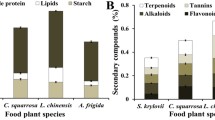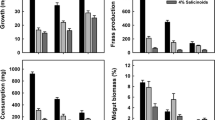Abstract
Diet selection based on the level of proline in an insect's host plant has been observed for a number of phytophagous insects, but few studies have examined potential differences in feeding preferences between males and females. The level of proline among an insect's host plants, particularly in drought-stressed plants, can be highly variable and often is positively correlated with soluble nitrogen levels. Additionally, proline is known to participate in a number of physiological functions in insects. We tested the effect of proline as a feeding stimulant in reproductively active grasshoppers using the graminivorous Ageneotettix deorum and the generalist, but mostly graminivorous, Phoetaliotes nebrascensis. Feeding preference tests using diets with representative free amino acid and sucrose levels but varying proline levels (zero, normal and 3 x normal) were examined. The feeding preference exhibited by both species was sex-specific, although the sex-specific response was more pronounced in P. nebrascensis than in A. deorum. Females of both species displayed preferences for diets high in proline. Males of neither species exhibited a preference for proline when responses were averaged over all treatment levels. However, within specific treatment combinations, male A. deorum preferred diets with high proline over diets with zero proline. These results suggest that diet selection for specific nutrients may vary between males and females because of differences in their physiological status and, possibly, differences in the nutritional requirements associated with reproduction. These results also suggest that subtle shifts in the concentration of individual nutrients within an insect's host plant may greatly influence insect feeding patterns.
Similar content being viewed by others
References
Aspinall D, Paleg LG (1981) Proline accumulation: physiological aspects. In: Paleg LG, Aspinall D (eds) Physiology and biochemistry of drought resistance in plants. Academic Press, New York, pp 206–241
Barnett NM, Naylor AW (1966) Amino acid and protein metabolism in bermuda grass during water stress. Plant Physiol 41:1222–1230
Behmer ST (1993) The influence of free amino acids and sucrose on the feeding responses of two graminivorous grasshoppers. MS thesis, University of Nebraska, Lincoln, Nebraska, USA
Behmer ST, Joern A (1993) Dietary selection by the generalist grasshopper, Phoetaliotes nebrascensis (Orthoptera: Acrididae) based on the need for phenylalanine. Funct Ecol 7:522–527
Bently MD, Leonard DE, Leach S, Reynolds E, Stoddard W, Tomkinson B, Tomkinson D, Strunz G, Yatagai M (1982) Effect of some naturally occurring chemicals and extracts of non-host plants on feeding by spruce budworm larvae, Chroristoneura fumiferana. Maine Agric Exp Stn Tech Bull 107
Bernays EA, Barbehenn R (1987) Nutritional ecology of grass foliage-chewing insects. In: Slansky F, Rodriquez JG (eds) Nutritional ecology of insects, mites, spiders and related invertebrates. Wiley and Sons, New York, pp 147–176
Bernays EA, Simpson SJ (1982) Control of food intake. Adv Insect Physiol 16: 59–118
Bernays EA, Simpson SJ (1990) Nutrition. In: Chapman RF, Joern A (eds) Biology of grasshoppers. Wiley and Sons, New York, pp 105–127
Bokhari UG, Trent JD (1985) Proline concentration in water stressed grasses. J Range Manage 38:37–38
Boys HA (1978) Food selection by Oedaleus senegalensis (Orthoptera: Acrididae) in grassland and millet fields. Entomol Exp Appl 24:78–86
Bursell E (1981) The role of proline in energy metabolism. In: Downer RGH (ed) Energy metabolism in insects. Plenum Press, New York, pp 135–154
Capinera JL, Sechrist TS (1982) Grasshoppers (Acrididae) of Colorado: identification, biology and management (Bullentin 584S). Colorado State University Experiment Station, Fort Collins
Chapman RF (1990) Food selection. In: Chapman RF, Joern A (eds) Biology of grasshoppers. Wiley and Sons, New York, pp 39–72
Chapman RF, Bernays EA, Wyatt T (1988) Chemical aspects of host-plant specificity in three Larrea-feeding grasshoppers. J Chem Ecol 14:561–579
Cook AG (1977) Nutrient chemicals and oligophagy in Locusta migratoria. Ecol Entomol 2:113–121
Ford ED (1984) The dynamics of plantation grwoth. In: Bowen GD, Nambiar EKS (eds) Nutrition of plantation forests. Academic Press, New York, pp 17–52
Gomez KA, Gomez AA (1984) Statistical procedures for agricultural research. Wiley and Sons, New York
Haglund BM (1980) Proline and valine — cues which stimulate grasshopper herbivory during drought stress? Nature 288:697–698
Heron RJ (1965) The role of chemotactic stimuli in the feeding behavior of spruce budworm larva of white spruce. Can J Zool 43:247–269
Joern A (1979) Feeding patterns in grasshoppers (Orthoptera: Acrididae): factors influencing diet specialization. Oecologia 38:325–347
Joern A (1985) Grasshopper dietary from a Nebraska sand hills prairie. Trans Nebraska Acad Sci 8:21–32
Karamanos AJ, Drossopoulos JB, Niavis CA (1983) Free proline accumulation during development of two wheat cultivars with stress. J Agric Sci 100:429–439
Kozlowski TT, Kramer PJ, Pallardy SG (eds) (1991) The physiological ecology of woody plants. Academic Press, San Diego
Lyttleton JW (1973) Amino acids, peptides and ureides. In: Butler G, Bailey R (eds) Chemistry and biochemistry of herbage. Academic Press, New York, pp 63–103
Ma WC (1972) Dynamics of feeding responses in Pieris brassicae L. as a function of chemosensory input: a behavioral, ultrastructural and electrophysiological study. Meded Landbouwhogesch Wageningen 72:1–62
Mattson WJ, Haack RA (1987a) The role of drought stress in provoking outbreaks of phytophagous insects. In: Barbosa P, Schultz JC (eds) Insect outbreaks. Academic Press, San Diego, pp 365–407
Mattson WJ, Haack RA (1987b) The role of drought in outbreaks of plant-eating insects. BioScience 37:110–118
Mooney HA, Winner WE, Pell EJ (eds) (1991) The intergrated response of plants to stress. Academic Press, San Diego
Onsager JA, Mulkern GB (1963) Identification of eggs and egg pods of North Dakota grasshoppers (Orthoptera: Acrididae). N D Agric Exp St Bull 446:1–48
Otte D, Joern A (1977) On feeding patterns in desert grasshoppers and the evolution of specialized diets. Proc Acad Nat Sci Philadelphia 128:89–126
Prestridge RA, McNeil S (1983) The role of nitrogen in the ecology of grassland Auchenorryncha. In: Lee JA, McNeil S, Rorison IH (eds) Nitrogen as an ecological factor. Blackwell Scientific, Oxford, pp 257–281
Rhoades DF (1979) Evolution of plant chemical defense against herbivores. In: Rosenthal GA, Janzen DH (eds) Herbivores: their interaction with secondary plant metabolites. Academic Press, London, pp 3–54
Sacktor B (1974) Biological oxidations and energetics in insect mitochondria. In: Rockstein M (ed) The physiology of insecta Academic, New York, pp 271–354
Siegel S (1956) Nonparametric statistics. McGraw-Hill, New York
Simpson SJ (1982) Changes in the efficiency of utilisation of food throughout the fifth-instar nymphs of Locusta migratoria. Entomol Exp Appl 31:265–275
Simpson SJ (1990) The pattern of feeding. In: Chapman RF, Joern A (eds) Biology of grasshoppers. Wiley and Sons, New York, pp 73–103
Simpson SJ, Abisgold JD (1985) Compensation by locusts for changes in dietary nutrients: behavioural mechanisms. Physiol Entomol 10:443–452
Simpson SJ, Simpson CL (1990) The mechanisms of nutritional compensation by phytophagous insects. In: Bernays EA (ed) Insect-plant interactions. CRC Press, Boca Raton, pp 112–160
Simpson SJ, Simmonds MSJ, Blaney WM (1988) A comparison of dietary selection behaviour in larval Locusta migratoria and Spodoptera littoralis after a single deficient meal during ad libitum feeding. Physiol Entomol 13:225–238
Waring RH, Pitman GB (1985) Modifying lodgepole pine stands to change susceptibility to mountain pine beetle attack. Ecology 66:889–897
White TCR (1974) A hypothesis to explain outbreaks of looper caterpillars, with special reference to populations of Selidosema suavis in a plantation of Pinus radiata in New Zealand. Oecologia 22:119–134
White TCR (1984) The abundance of invetebrate hervivores in relation to the availability of nitrogen in stressed food plants. Oecologia 63:90–105
Wilkinson L (1990) SYSTAT: the system for statistics. SYSTAT Inc, Evanston
Wisiol K (1979) Clipping of water-stressed blue grama affects proline accumulation and productivity. J Range Manage 32:194–195
Yeoh H, Watson L (1982) Taxonomic variation in total leaf protein amino acid compositions of grasses. Phytochemistry 21:615–626
Author information
Authors and Affiliations
Rights and permissions
About this article
Cite this article
Behmer, S.T., Joern, A. The influence of proline on diet selection: sex-specific feeding preferences by the grasshoppers Ageneotettix deorum and Phoetaliotes nebrascensis (Orthoptera: Acrididae). Oecologia 98, 76–82 (1994). https://doi.org/10.1007/BF00326093
Received:
Accepted:
Issue Date:
DOI: https://doi.org/10.1007/BF00326093




